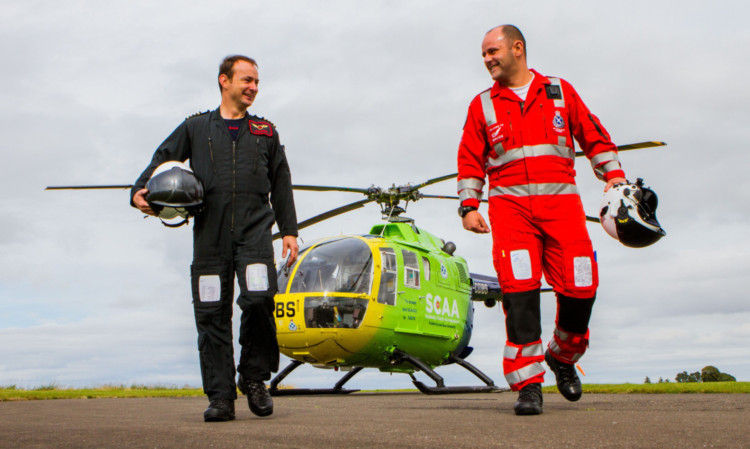The last four months have been a flurry of activity for the team of Scotland’s Charity Air Ambulance (SCAA).
The crew has carried out more than 135 missions while, behind the scenes, staff and volunteers have been working frantically to keep the helicopter in the air.
Now a familiar sight in the skies above Tayside and Fife, as well as further afield, the green and blue aircraft works alongside the two helicopters operated by the Scottish Ambulance Service (SAS).
Both organisations work together to ensure patients are given the best chance of survival by providing emergency assistance as quickly as possible.
Paramedic Bruce Rumgay has worked for the ambulance service since 1998 but has been based with SCAA since its launch in May.
Formerly a road paramedic, he completed his HEMS (Helicopter Emergency Medical Service) training in January so he could join the charity’s crew.
He revealed just how vital their work is, saying: “Getting the right level of care to the patient is pretty critical and if we can stabilise them, it can increase their chance of survival.
“The control centre vets calls to a certain degree but we can only really know what we’re getting once we get to the scene and see the patient. There have been a lot of jobs where we have helped improve the outcome.”
The task of getting Bruce and his colleagues to their patients falls to two highly-trained pilots.
They can get the paramedics from their base at Perth Airport to the other side of the country in a matter of minutes.
John Stupart, a former member of The Black Watch and Army Air Corps, has used his extensive flying experience to help save lives and get people the help they need.
He welcomed the service offered by SCAA, saying: “The aircraft definitely supplements and adds to the existing capabilities, especially on this side of the country as there is a large rural community within 30 minutes’ reach of us.
“The existing air ambulances do a lot of work across the country and one job can take them away for a couple of hours, so we fill a space when they are offline.”
Mr Stupart also revealed how people were starting to recognise the importance of the work carried out by SCAA and how vital this is for the charity’s future.
He continued: “It has to become self-sustainable the more people who know about SCAA’s work the better as they will come forward to help.
“One day when we landed in Pitlochry, people were asking questions because they had seen coverage in the papers and on TV.
“It was quite new to them and seeing a helicopter land in the town and two people rush off to help patients generated a lot of interest, so they all came along to find out more.
“Some people still don’t know it’s charity funded, so it’s just about getting the message out.”
National Air Ambulance Week is being used as a perfect opportunity to make more people aware of SCAA and the work it does.
The charity also hopes to encourage fundraisers to come forward to help meet the £1.5 million annual cost of keeping the helicopter in the air.
Chief executive Gavin Davey said: “The public response has been very good, but we can’t afford to take our foot off the gas here.
“We would like the public to use National Air Ambulance Week to give us a shot in the arm by joining our new lottery or making a donation on our new website. We have to raise funds to save lives.”
